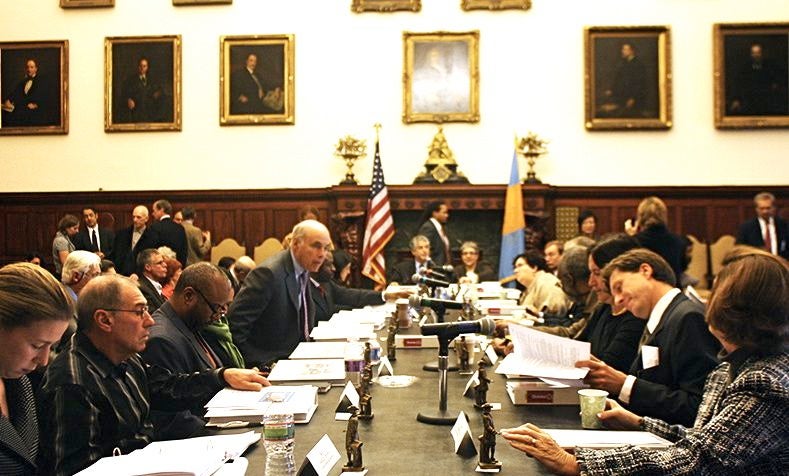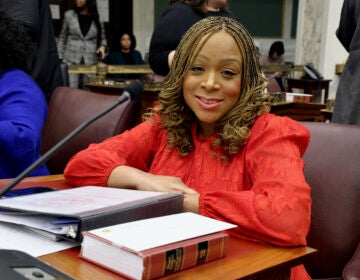A swell of protest over proposed zoning code amendments

During public hearings on the new zoning code in City Council last fall, a few witnesses sought to quell some Councilmembers’ misgivings about the new code by reminding them that, should any of its provisions prove problematic, it would be Council’s right to change the law.
Council need simply adopt the ZCC’s Final Report, they argued, and then fix any detrimental provisions ad hoc.
The arguments may have contributed to the short-term success of the legislation—it was adopted unanimously in December—but it looks now like Council is remembering who really runs things around here.
A handful of amendments to the code, in effect only since the end of August, are up for consideration this week in the Rules Committee as well as the whole Council.
And what was slowly, painfully wrought by thousands of Philadelphians over five years of hard thought, discussion and argument is where it was always going to end up: in the hands of just 17. Seventeen who tend to defer to each other’s expertise over that of anyone else.
The proposed changes to the code are as follows:
- Bill No. 120656, introduced by Councilman Brian O’Neill on behalf of Council President Darrell Clarke, would raise the minimum parking requirements in dense commercial and residential districts, increase the minimum lot size in the same districts, and create a special parking overlay for North Central Philadelphia. The bill was recommended favorably by the Rules Committee last month, and is on the second reading/final passage calendar for this week’s City Council meeting.
- Bill No. 120654, introduced by Councilmen Bobby Henon and Bill Green, would enact some version of a 50-foot buffer to development on the city’s rivers and streams that was adopted in the code last fall, but held back from taking effect in the spring. The bill will be considered in a continued hearing of the Rules Committee Wednesday morning at 10.
- Amendments to Bill No. 120774, the Planning Commission’s “clean-up bill,” would expand the notification requirements of the code’s provision on Registered Community Organizations. The amendments, offered by Councilwoman Jannie Blackwell, would require developers to notify not only the RCO but also everyone living within one block of the address where a project is proposed. They would also give the district councilmember the authority to require more than one meeting between neighborhood groups and developers; the new code requires a single, joint meeting.
- More amendments to the same bill proposed by Councilman O’Neill would roll back the classifications of a few dozen use categories in commercial and industrial districts. It would prohibit transit stations and pet stores, for example, in the CMX-2 district, where those uses are currently allowed by right. Bill No. 120774, and its proposed amendments, will be considered at the Rules Committee Wednesday morning.
More parking, bigger apartments
In the past few weeks, planning advocates, civic organizations, attorneys, Zoning Code Commissioners, Average Joes, bloggers, reporters, and columnists have raised questions about the propriety of Council President Clarke’s proposal, which would effectively bring more cars into the city’s densest urban neighborhoods.
Members of the Temple Area Property Association testified that it would hamper development in North Central Philadelphia. A staffer at the Planning Commission posted on the staff blog a strongly worded plea for Council to let the code set in; that post has since been taken down. Inga Saffron at the Inquirer wrote that changing the whole code to solve a parking problem in one neighborhood was akin to “using a cleaver to mince garlic.”
Peter Kelsen, a former Zoning Code Commissioner said the parking regulations were arrived at after a thoughtful process, and that if Clarke needs to respond to a specific problem, he should create a more specific solution.
“We spent a huge amount of time with a lot of expert backup figuring out what the parking need is for these districts,” Kelsen said.
Council may take a vote on the bill as soon as this Thursday, Nov. 15th.
Protecting rivers and streams
The bill that would enact a buffer to new development on the city’s waterways has gone through what feels like countless iterations since debate over its language started up again last June. The latest version includes an amendment proposed by Councilmen Henon and Green that would allow existing buildings less than 50 feet from stream banks to expand.
The Planning Commission has advocated for a regulation that would make the development process predictable by calling for a citywide buffer of 50 feet. The Henon/Green amendment would enact a smaller buffer on parcels that have buildings less than 50 feet from the bank. If a parcel had a building 20 feet from the top of a stream or river bank, the buffer on that whole parcel would be 20 feet. Henon said the bill was intended to allow existing buildings to expand within the 50-foot buffer, but not to allow new buildings that close to waterways.
The Rules Committee will take up the issue again Wednesday morning, at which point it may choose to adopt Henon’s amendments, or another set of amendments, or recommend the bill be passed as introduced.
Cleaning up the code, and then some
Councilwoman Blackwell’s proposed changes to the Registered Community Organization provision of the new code have raised concerns among developers, planners, and community organizations alike.
Eva Gladstein, deputy director of the Planning Commission, said that Blackwell’s amendments are “very confusingly written” and may throw off what she described as a delicate balance, difficultly arrived at in the zoning reform process, between streamlining development and maximizing community input. Most troubling, Gladstein said, was the insertion of the district councilmember into the process, giving him or her the right to decide whether one or more meetings should be held between neighborhood groups and developers.
“We had asked her to limit or cap the number of meetings [in her amendment],” said Gladstein, “but she didn’t feel that was appropriate.”
Kiki Bolender, an architect and chair of the Design Advocacy Group who directed the “Common Ground for Building Our City” project during zoning reform, echoed Gladstein’s concern.
“The whole impetus for the RCO, in my mind, was to get the neighbors to talk to one another, work through the difficult issues and be ready to speak with one strong and informed voice,” Bolender wrote in an email to PlanPhilly. “That one voice would be obliged to deal with the concerns of the near neighbors, which will very often be at odds with the interests of the community and the city. … During the Common Ground project, we met over 80 of these civic leaders and believe me, they can do it. They can find common ground. They are smart and compassionate and they can do the hard work to make this happen. But they cannot succeed if the Councilperson is standing over them, ready to anoint the winners and losers.”
Harris Sokoloff, director of the University of Pennsylvania’s Project for Civic Engagement who worked with Bolender on the Common Ground report, intends to testify in support of the code’s current RCO provision at a hearing on the issue this Friday. Sokoloff’s testimony is attached to this article.
It should be noted that a hearing on the RCO issue was scheduled for October 29th, two days before the first Committee hearing on the clean-up bill Blackwell wants to amend, but canceled because of Hurricane Sandy. A new hearing is scheduled for Friday, Nov. 16th, although the Rules Committee may well make a recommendation on the amendments on Wednesday.
The most curious among the proposed changes to the code is Councilman O’Neill’s proposal to change the use tables for certain commercial and industrial districts. O’Neill’s office has not returned calls for comment on this issue, but according to Eva Gladstein, his changes would make some uses in the CMX-2 district conform to the classifications of the old code’s RC-2 district.
Gladstein said that the RC-2 district was hyperspecific, applying to only about 0.005% of all commercially zoned land in Philadelphia. The CMX-2 district, by contrast, accounts for around a third of commercial land in the city, and more in some Councilmanic districts. But she said that in O’Neill’s district, it only applies to around ten percent of commercial parcels.
Gladstein said that some of the changes are “frankly pretty absurd,” and that the Planning Commission finds it “unacceptable” to add them to its cleanup bill. She said that she told O’Neill’s office to introduce its own bill if it is interested in making the proposed use changes.
“It’s a huge change,” Gladstein said. “It affects his district less than the rest of the city, and we didn’t understand what problem it was trying to solve.”
A question of process
Craig Schelter, a spokesman for the Development Workshop, says it’s no surprise that Council is introducing amendments to the code already, and he sees nothing wrong with it.
“I don’t think there’s anybody who wants to subvert the new code,” Schelter told PlanPhilly last week. “It’s thoughtful people thinking, ‘Gee this is what we’ve got. How can I fix this?’”
But Schelter also said that the Planning Commission opened the door to these changes with its clean-up bill, which fixes typos and clarifies definitions—among many other small changes—in the new code. Schelter said that some of the “clean-up” amendments were policy issues, and that Council is simply responding in kind. Councilman Mark Squilla made similar comments to a City Paper reporter last week.
“I think that’s a lousy attitude,” said Eva Gladstein. “We had said even when we handed Council the Final Report that we would be doing the clean-up amendments … Literally, they really are technical amendments, they’re not substantive in nature – they’re not based on the fact that we’re rethinking something that we did.”
If Gladstein had her way, the clean-up bill would pass through Council unamended, and Council members would wait until city agencies make a report about the code’s first year before changing it. Others from the Zoning Code Commission feel the same way.
Said Peter Kelsen, a land use attorney at Blank Rome, “I think that the idea was to allow the code to move forward and look at things after a certain period of time to make sure that it was working or not working, and not to fix things that we’re not sure are not working yet.”
Joe Schiavo, of Old City Civic Association and the Central Delaware Advocacy Group, said the zoning code is compromise incarnate—that everyone involved in the reform process had to give up something he or she wanted. He said that now that Council is amending the code to its own specifications, he wonders whether OCCA and other groups should just start doing the same thing, asking for changes to reflect their particular desires.
“OCCA lost most of the controls it had in its overlay,” Schiavo said. “Should I be raising a stink about that? I don’t think that’s appropriate …”
He feels, like so many others, that Council should let the code take full effect before employing its unique power to tinker with it.
“[Council members] had many opportunities to participate in the process,” Schiavo said, “and I wish they had exercised those options rather than wait for the process to be complete and then begin making these recommendations for adjustment. I find it very frustrating. I find it disenfranchising, frankly.”
Note: This article has been updated to reflect that the RC-2 District in the old code covered 0.005% of commercial land in Philadelphia, not 0.0005%. PlanPhilly regrets the error.
Contact the reporter at jaredbrey@gmail.com and follow him on Twitter @jaredbrey
WHYY is your source for fact-based, in-depth journalism and information. As a nonprofit organization, we rely on financial support from readers like you. Please give today.






